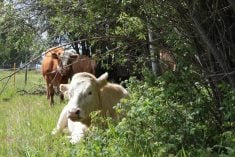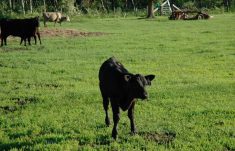Scours is the number-one killer of calves under two months of age. It takes many different management strategies to prevent scours and it is important to know that it is caused by many different things.
The following points will offer some ideas to reduce the buildup of organisms and increase resistance in your calves. Disease organisms come from dirt, manure and other calves, so we need to keep this in mind. Scours is the one disease where management changes and how you handle the first case will determine how many you are faced with at the end of the year.
Read Also

Harvest wraps up and fall work begins
At the Eppich famly ranch in western Saskatchewan, the fall harvest was successful with few breakdowns, cows and calves have been sorted and a new tractor has arrived
Management factors
- Clean calving-area barns and maternity pens early. Spray with disinfectant. Keep these areas squeaky clean. Do this as quickly as you can after calving season. Try not to run cattle in the area until just before calving season
- Have cows in good body condition score at calving (2.5-3.5 BCS) and be feeding the proper mineral supplementation. Test feed. Cows in good shape will produce good-quality colostrum. Overweight cows can increase calving problems. Internal fat in the pelvis leads to tighter (more difficult) deliveries.
- If calving in winter, try and mother up cow and calf for 24 hours in a separate pen to ensure suckling begins as early as possible after birth. If weather is very cold (lows of -15 or colder) several days in a row, plan to provide creep areas for the calves as soon as they are out of the barn. Most producers with creep areas in every pen find calves are less stressed, stay warmer and have fewer instances of scours and pneumonia as a result.
- Pay particular attention to twins, hard pulls, calves slow to rise, calves on cows in poor condition, calves with a poor suckle reflex after 20 minutes, or calves on cows with poor udders or poor teat conformation. Plan to administer colostrum (natural or substitute) immediately to ensure the calf gets the nutrients it needs. If in doubt in any way about whether a calf has sucked or is low on vigour, give it colostrum. Pay attention to the quality of the substitute colostrum. Saskatoon Colostrum company (Headstart) makes some of the best powdered colostrum.
- It is very important to scours-vaccinate cows and heifers according to the recommended timing. It takes colostrum upwards of five weeks to form immunity in the calf. Ensure heifers and any new additions to the herd in the last year are scours-vaccinated and given the booster. There are three scours vaccines on the market, all with pretty similar efficacy. Work with your veterinarian to best match the vaccine to your operation, depending on your time before calving. If you are calving at different times it may warrant changing vaccines. Ease of administration may come into play as well, as two of the products are given intramuscular and one subcutaneously. But again, make the best choice depending on your veterinarian’s recommendation. This is why most veterinary clinics will carry at least two of the scours vaccines, because timing is very critical.
- It is not recommended to purchase bred cows before the calving season. If you do, try and isolate them somewhat from the rest of the herd. These animals have not been exposed to diseases or bacteria that may live on your place and have not built up immunity. And it is vice versa for your cows — they may not have any immunity to pathogens the new cattle may bring to your farm. The most critical time for biosecurity is during spring calving.
- Never ever bring in new calves from another herd, especially a Holstein. These may introduce scour agents such as cryptosporidiosis which is not covered by any of the scour vaccines.
- Apply biosecurity measures and don’t allow visitors to the farm, especially in calving season. As a precaution have a supply of clean boots or booties and use boot dips when moving around and between pens.
- Ideally, calve heifers ahead of cows and in a separate area.
- Have a coccidiosis-prevention program such as rumensin (monensin) in the ration. Often producers when starting to creep feed may put in a product called Deccox for coccidiosis prevention.
- Use a separate esophageal feeder for newborns or calves with scours or other conditions. Keep each feeder labelled and disinfect the tubes between usages.
- Limit the number of new cow-calf pairs to 30, 50 or perhaps 70 head, depending on the size of pen, field and size of herd. Don’t mix pens as calving season progresses. Eliminate any standing water.
- If any scours cases are detected, have your veterinarian check for cryptosporidiosis to make sure it is not present. The best/first treatment for any sick animals should be electrolytes given orally. Your veterinarian will advise you of the best treatment schedule and whether any need IV fluids.
- If the scouring calf and mother don’t respond after one treatment, the rule of thumb is to isolate them from the others in the herd.
- Have and use a disinfectant in a boot dip tray. Use separate coveralls for treating sick calves versus coveralls worn while working with newborns. Have an isolation area away from the calving barn for sick pairs.
- Use a calving suit that can be washed. and wash the chains and calf puller before putting them away.
- After treating calves, make sure to clean the area, coveralls and disinfected boots to help protect healthy calves. Isolate sick calves with mothers
- If the weather is good, minimize movement through the barn and isolate more-fractious cows with their calves in a quiet area.
Hopefully, from these points you can find one or two to improve on for this calving season. Hopefully, it will be an uneventful season with very little sickness and disease.















